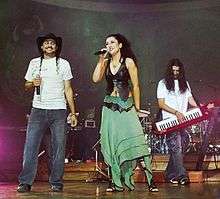Camela
Camela is a Spanish musical group credited with being the creators and precursors of the style baptised as tecno-rumba in the 90s. Its members are Dionisio Martin Lobato (singer-composer), María de los Ángeles Muñoz Dueñas (singer-songwriter), and until February 2013, Miguel Angel Jimenez Cabrera (keyboards), all of them naturals from the Madrid neighbourhood of San Cristóbal de los Ángeles. The group is landmark for the Spanish popular music scene, without critics acceptance, and hardly any support from the media, they became a massive selling success, having a great musical and sociological impact on Spanish society. Camela is the second best selling band in Spain in the past 20 years, only surpassed by La Oreja de Van Gogh.
Camela | |
|---|---|
 | |
| Background information | |
| Origin | Spain |
| Genres | Tecno-rumba, Techno, pop, flamenco |
| Years active | 1994–present |
| Labels | EMI |
| Website | www |
| Members | María Ángeles Muñoz Dueñas (20 August 1974)[1] Dionisio Martín Lobato (31 October 1970)[2] Miguel Ángel Cabrera Jiménez (25 January 1972)[3] |
Discography
Studio albums
- 1994: Lágrimas de amor
- 1995: Sueños inalcanzables
- 1996: Sus 12 primeras canciones
- 1997: Corazón indomable
- 1998: Sólo por ti
- 1999: No puedo estar sin él
- 2000: Simplemente amor
- 2001: Amor.com
- 2003: Por siempre tú y yo
- 2004: Diez de corazón
- 2006: Se ciega x amor
- 2007: Te prometo el universo
- 2008: Laberinto de amor
- 2009: Dioni, Ángeles y Miguel
- 2011: La magia del amor
- 2014: Más de lo que piensas
- 2017: Me metí en tu corazón
gollark: Indeed.
gollark: Don't give up. if you believe in yourself, you can do anything. Literally anything.
gollark: If you wanted to, you should have.
gollark: When have I EVER said stupid things?
gollark: See, I think you're just doing things badly.
References
- https://web.archive.org/web/20101210071258/http://www.clubdefanscamela.com/biografia/angeles/angeles1.html. Archived from the original on December 10, 2010. Retrieved August 20, 2012. Missing or empty
|title=(help)
External links
This article is issued from Wikipedia. The text is licensed under Creative Commons - Attribution - Sharealike. Additional terms may apply for the media files.